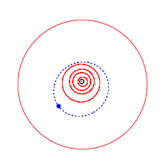9963 Sandage
|
Orbits of 9963 Sandage (blue), inner planets (red) and Jupiter (outermost) | |
| Discovery [1] | |
|---|---|
| Discovered by | E. F. Helin |
| Discovery site | Palomar Obs. |
| Discovery date | 9 January 1992 |
| Designations | |
| MPC designation | 9963 Sandage |
Named after |
Allan Sandage (astronomer)[2] |
|
1992 AN · 1976 NH 1989 CK6 | |
| main-belt · Phocaea [3] | |
| Orbital characteristics [1] | |
| Epoch 16 February 2017 (JD 2457800.5) | |
| Uncertainty parameter 0 | |
| Observation arc | 27.76 yr (10,139 days) |
| Aphelion | 2.9985 AU |
| Perihelion | 1.6832 AU |
| 2.3409 AU | |
| Eccentricity | 0.2809 |
| 3.58 yr (1,308 days) | |
| 77.520° | |
| 0° 16m 30.72s / day | |
| Inclination | 23.462° |
| 116.97° | |
| 241.15° | |
| Earth MOID | 0.7730 AU |
| Physical characteristics | |
| Dimensions |
5.45 km (calculated)[3] 6.371±0.174 km[4][5] |
|
4.6502±0.0008 h[6] 4.65053±0.00013 h[7] | |
|
0.158±0.025[4][5] 0.23 (assumed)[3] | |
| S [3] | |
| 12.9[1] · 12.95±0.25[8] · 13.080±0.002 (R)[6] · 13.53[3] · 13.6[4] | |
|
| |
9963 Sandage, provisional designation 1992 AN, is a stony Phocaea asteroid from the inner regions of the asteroid belt, approximately 6 kilometers in diameter. It was discovered by American female astronomer Eleanor Helin at the U.S. Palomar Observatory in California on 9 January 1992.[9]
The stony S-type asteroid is a member of the Phocaea family, a group of asteroids with similar orbital characteristics. It orbits the Sun at a distance of 1.7–3.0 AU once every 3 years and 7 months (1,308 days). Its orbit has an eccentricity of 0.28 and an inclination of 23° with respect to the ecliptic.[1] The first used observation was taken at the German Karl Schwarzschild Observatory in 1989, extending the asteroid's observation arc by 3 years prior to its discovery.[9]
Two rotational light-curve for this asteroid were obtained from photometric observations at the Palomar Transient Factory and at Texas Tech's Preston Gott Observatory in November 2011 and June 2016, respectively. The light-curves gave a rotation period of 4.65 hours with a high brightness variation of 0.56 and 0.43 in magnitude, respectively (U=2/3-).[6][7]
According to the survey carried out by the NEOWISE mission of NASA's Wide-field Infrared Survey Explorer, the asteroid measures 6.4 kilometers in diameter and its surface has an albedo of 0.16,[4] while the Collaborative Asteroid Lightcurve Link assumes an albedo of 0.23 – derived from the family's largest member and namesake, 25 Phocaea – and calculates a diameter of 5.5 kilometers, based on an absolute magnitude of 13.53.[3]
The minor planet was named after American astronomer Allan Sandage (1926–2010), a worldwide known expert on stellar astronomy and observational cosmology, who worked at Palomar and Mount Wilson Observatory.[2] Sandage determined the first reasonably accurate values for the Hubble constant and also discovered the first quasar. Naming citation was published on 2 September 2001 (M.P.C. 43381).[10]
References
- 1 2 3 4 "JPL Small-Body Database Browser: 9963 Sandage (1992 AN)" (2016-11-08 last obs.). Jet Propulsion Laboratory. Retrieved 4 December 2016.
- 1 2 Schmadel, Lutz D. (2007). Dictionary of Minor Planet Names – (9963) Sandage. Springer Berlin Heidelberg. p. 715. ISBN 978-3-540-00238-3. Retrieved 1 August 2016.
- 1 2 3 4 5 6 "LCDB Data for (9963) Sandage". Asteroid Lightcurve Database (LCDB). Retrieved 1 August 2016.
- 1 2 3 4 Mainzer, A.; Grav, T.; Masiero, J.; Hand, E.; Bauer, J.; Tholen, D.; et al. (November 2011). "NEOWISE Studies of Spectrophotometrically Classified Asteroids: Preliminary Results". The Astrophysical Journal. 741 (2): 25. arXiv:1109.6407
 . Bibcode:2011ApJ...741...90M. doi:10.1088/0004-637X/741/2/90. Retrieved 1 August 2016.
. Bibcode:2011ApJ...741...90M. doi:10.1088/0004-637X/741/2/90. Retrieved 1 August 2016. - 1 2 Masiero, Joseph R.; Mainzer, A. K.; Grav, T.; Bauer, J. M.; Cutri, R. M.; Dailey, J.; et al. (November 2011). "Main Belt Asteroids with WISE/NEOWISE. I. Preliminary Albedos and Diameters". The Astrophysical Journal. 741 (2): 20. arXiv:1109.4096
 . Bibcode:2011ApJ...741...68M. doi:10.1088/0004-637X/741/2/68. Retrieved 4 December 2016.
. Bibcode:2011ApJ...741...68M. doi:10.1088/0004-637X/741/2/68. Retrieved 4 December 2016. - 1 2 3 Waszczak, Adam; Chang, Chan-Kao; Ofek, Eran O.; Laher, Russ; Masci, Frank; Levitan, David; et al. (September 2015). "Asteroid Light Curves from the Palomar Transient Factory Survey: Rotation Periods and Phase Functions from Sparse Photometry". The Astronomical Journal. 150 (3): 35. arXiv:1504.04041
 . Bibcode:2015AJ....150...75W. doi:10.1088/0004-6256/150/3/75. Retrieved 1 August 2016.
. Bibcode:2015AJ....150...75W. doi:10.1088/0004-6256/150/3/75. Retrieved 1 August 2016. - 1 2 Clark, Maurice (January 2016). "Asteroid Photometry from the Preston Gott Observatory". The Minor Planet Bulletin. 43 (1): 2–5. Bibcode:2016MPBu...43....2C. ISSN 1052-8091. Retrieved 1 August 2016.
- ↑ Veres, Peter; Jedicke, Robert; Fitzsimmons, Alan; Denneau, Larry; Granvik, Mikael; Bolin, Bryce; et al. (November 2015). "Absolute magnitudes and slope parameters for 250,000 asteroids observed by Pan-STARRS PS1 - Preliminary results". Icarus. 261: 34–47. arXiv:1506.00762
 . Bibcode:2015Icar..261...34V. doi:10.1016/j.icarus.2015.08.007. Retrieved 1 August 2016.
. Bibcode:2015Icar..261...34V. doi:10.1016/j.icarus.2015.08.007. Retrieved 1 August 2016. - 1 2 "9963 Sandage (1992 AN)". Minor Planet Center. Retrieved 1 August 2016.
- ↑ "MPC/MPO/MPS Archive". Minor Planet Center. Retrieved 1 August 2016.
External links
- Asteroid Lightcurve Database (LCDB), query form (info)
- Dictionary of Minor Planet Names, Google books
- Asteroids and comets rotation curves, CdR – Observatoire de Genève, Raoul Behrend
- Discovery Circumstances: Numbered Minor Planets (5001)-(10000) – Minor Planet Center
- 9963 Sandage at the JPL Small-Body Database

